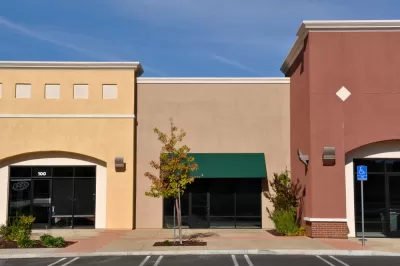As consumers increasingly buy online, technology is changing the shape of our cities, reducing demand for retail space, increasing freight congestion, and leaving parking lots empty.

As I look at plans across the country, there are always beautiful images of people strongly along sidewalks window shopping in vibrant mixed-use centers with plenty of shops. As planners, we tend to see retail as an essential part of our communities. However, as I reflect on my own changing shopping patterns over the last few years, I recognize a dramatic shift in the amount of shopping I am doing online.
A 2014 study found that 78 population of the U.S. population over the age of 15 bought something online in the first quarter of that year. A 2013 study found 69 percent of U.S. adults make purchases online at least monthly and 33 percent shop online weekly. If there is a child in the home you are more likely to make weekly online purchases: 40 percent of households with one child, 56 percent of households with two children, and 66 percent of households with three or more children. Consumers between the ages of 25 and 33 spend more online than any age group—averaging $2,000 per year.
In 2014, the U.S. Department of Commerce noted that e-retailers made up 8.3 percent of total unadjusted retail sales, excluding food service, fuel and automobiles—up from 7.4 percent in 2013. The U.S. Department of Commerce reports that in 2015 retail sales grew modestly—1.4 percent over 2014. Yet the portion of retail sales in the online world has ticked up substantially. A Forrester Research study predicts that by 2018, internet shopping will account for 11 percent of all purchases.

This shift of purchase from in town stores to the web, means a shift in demand for retail space. We are seeing demand for neighborhood and community retail space lagging, even though consumer spending is robust. The first waves of stores to disappear are toys, books, and electronics. Next up is clothing, as women increasingly become comfortable with ordering apparel online and returning as needed. This trend is of significant concern for planners in suburban areas, as declines in shopping malls, lifestyle centers, and power centers typically have significant apparel retailers. Lower quality shopping centers in secondary locations will continue to see stores pulling out of these locations. Of the 1,200 malls across the United States, 15 percent are 30-50 percent vacant. Since 2010 more than a dozen shopping malls have closed, with 60 that are on the brink of closure.
Major retailers are focusing on their physical presence as a branding opportunity. This means that retailers will have a smaller number of stores in a particular region and these retailers will be concentrated in shopping areas that match their brand impression. These shopping centers are being curated to create a special character among the mix of stores—with the hope that consumers will feel that they are in a special place with the best of everything. This means that people aren't just going for shopping as in the past—they are going for an experience of something they can't get online. This can include everything from celebrity chef restaurants, public art and activities.
Of course all this online shopping is having an impact on our transportation networks. As I recently reported, there is a low occupancy in retail parking lots. A recent U.S. Department of Transportation study found that online shopping will be a major contributor to the 45 percent increase in freight traffic on U.S. roads every year by 2040. Currently the "last mile" of freight movement is highly inefficient, creating noise and air pollution in neighborhoods. While there is potential for Unmanned Aerial Systems (drones), there is significant concern about air traffic congestion. The Federal Aviation Administration authorized the first test delivery last year, but all signs are we are years off from any real delivery system. The FAA will first need to develop a regulatory framework for deliveries.

What changes are you seeing in retail demand in your community? Is development of retail still strong? Is the type of retail coming in changing? How is your community planning for the changes in retail? Are you changing the way you approach your comprehensive and neighborhood plans to account for the changing nature of retail? Share what's happening in your community in the comments below.

Alabama: Trump Terminates Settlements for Black Communities Harmed By Raw Sewage
Trump deemed the landmark civil rights agreement “illegal DEI and environmental justice policy.”

Study: Maui’s Plan to Convert Vacation Rentals to Long-Term Housing Could Cause Nearly $1 Billion Economic Loss
The plan would reduce visitor accommodation by 25% resulting in 1,900 jobs lost.

Planetizen Federal Action Tracker
A weekly monitor of how Trump’s orders and actions are impacting planners and planning in America.

Wind Energy on the Rise Despite Federal Policy Reversal
The Trump administration is revoking federal support for renewable energy, but demand for new projects continues unabated.

Passengers Flock to Caltrain After Electrification
The new electric trains are running faster and more reliably, leading to strong ridership growth on the Bay Area rail system.

Texas Churches Rally Behind ‘Yes in God’s Back Yard’ Legislation
Religious leaders want the state to reduce zoning regulations to streamline leasing church-owned land to housing developers.
Urban Design for Planners 1: Software Tools
This six-course series explores essential urban design concepts using open source software and equips planners with the tools they need to participate fully in the urban design process.
Planning for Universal Design
Learn the tools for implementing Universal Design in planning regulations.
Caltrans
Smith Gee Studio
Institute for Housing and Urban Development Studies (IHS)
City of Grandview
Harvard GSD Executive Education
Toledo-Lucas County Plan Commissions
Salt Lake City
NYU Wagner Graduate School of Public Service






























